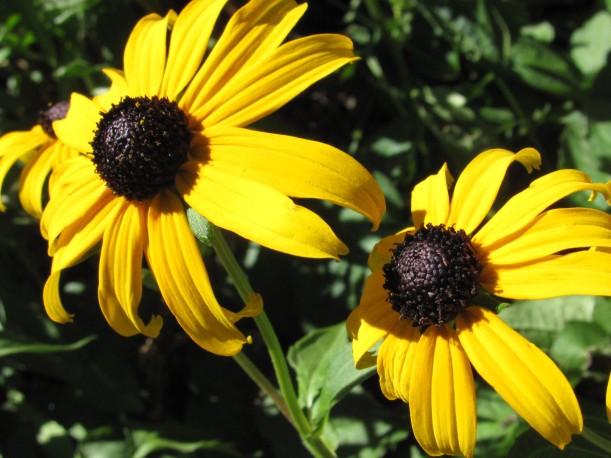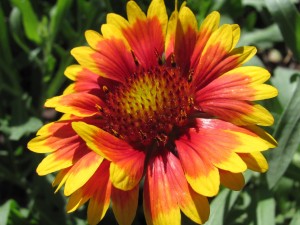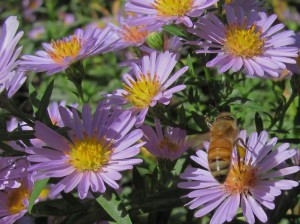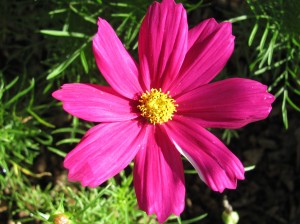For hidden captions, hover cursor over photo.
Irresistible flowers offered at farmers market
Published Sept. 1, 2019, in the Wyoming Tribune Eagle, “Irresistible flowers at farmers’ market”
By Barb Gorges
My guilty pleasure at the Tuesday Farmers Market is not the baked goods. It’s the flowers. This year I caved and started bringing home bouquets.
This is the fifth year Vally Gollogly of Cheyenne has been offering cut flowers at the booth she shares with partner Rusty Brinkman (see https://cheyennegardengossip.wordpress.com/2016/09/13/heirloom-veggies-for-taste-and-variety/). They are also the proprietors of Crow Creek Catering. Their vegetables look delicious, but the flowers look like candy. I think the grocery stores figured this out long ago.
Many of Vally’s arrangements are under $10 and fit in glass jars, a personal size. I try to remember to bring my own drink cup to transfer them, so I can put them in a car cupholder for the trip home.
This year, the gladioli in the arrangements stand out–so many vibrant blooms lined up on one stalk.
I don’t think of this elegant, exotic relative of the iris, its name Latin for “sword” (think “gladiator”) being something easy to grow in Cheyenne.
A tropical plant, most of the 250-plus gladiolus species are not expected to overwinter here. They require “lifting,” as the horticulturists say. When the leaves wither and before the first freeze, the gladiolus corms or bulbs, fat roots, need to be dug up and dried in the sun a couple days. Then you brush the dirt off and store them loosely indoors someplace that stays cool and dark and where any excess moisture evaporates rather than forms mold. Gollogly winters her bulbs in an old darkroom.

Gladiolus ‘Atom’
I can’t resist gladioli at the market and Vally can’t resist buying gladioli bulbs to grow. Some of her selections this year are Acidanthera bicolor (fragrant, white with maroon center), Gladiolus ‘Windsong’ (pink with yellow centers), G. ‘Atom’ (bright orangey red with white edges), G. ‘Glamini Charlotte’ (buttery white) and G. ‘Green Star’ (lime-green).
Vally is experimenting with Gladiolus nanus this coming winter. It is among the smaller glads, 12-18 inches tall. It is rated as hardy in USDA Zone 4, or 5–Cheyenne’s winter-hardiness rating. I noticed High Country Gardens, specializing in plants for Rocky Mountain-area gardening, suggests they be well-mulched.

Vally grows tender flowers in a high tunnel.
Anyone in Cheyenne who is a serious market gardener grows the tender vegetables, tomatoes, peppers and eggplant, in a hoop house, or high tunnel. Vally and Rusty have two. Much of one is devoted to gladioli, dahlias, Persian and regular zinnias and other cutting flowers. In the soft light the flowers, especially the dahlias, grow longer stems, great for flower arranging.
Juicy blooms, like juicy fruits and vegetables, require a lot of water. The high tunnels are on drip irrigation so no water is wasted by the wind.
Juicy blooms are appealing to pests. In summer the tunnel sides are rolled up to regulate the temperature inside. This year, big yellow grasshoppers have volunteered to trim the dahlia flowerheads perfectly. They take off only the petal tips, leaving a tight cone of color. It’s so perfect, you think it is supposed to look like that, good enough for a flower arrangement.
For hidden captions, hover cursor over photo.
Vally’s preferred time to cut flowers for market is the evening before. If a few leaves are left on the plant when you cut the gladiolus stalk, it helps it regenerate. Cutting either evening or early morning when they are unstressed means flowers will last longer—nearly a week for Vally’s arrangements. Her greenery and other flowers come from the volunteers along the edges of the vegetable patches–whatever catches her eye before market day.
Having a good eye is important in the presentation of fruits, vegetables and flowers at the market, or at the Laramie County Fair. Vally walked off with 42 blue ribbons (plus two Grand Champions and one Reserve Champion) this year, not only in floriculture and horticulture, but also in culinary, especially preserves and dried foods.
Vally’s enterprise echoes the slow flowers movement, https://slowflowers.com/, the idea that we should support local flower growers instead of buying flowers flown in from South America. The Front Range of Colorado was a hotbed of floriculture until the U.S. encouraged South Americans to get into the U.S. cut flower trade in the 1980s in lieu of growing opium poppies, so I’ve heard. Buying local flowers at the farmers market is a first step in reclaiming our regional heritage.
Vally remembers the lush greenness of a childhood in Ireland and how tough it was to adapt to desert gardening when the family moved to Santa Fe. In comparison, she finds Cheyenne to be a happy medium. Growing flowers makes her happy. Bringing her flowers home makes me happy.
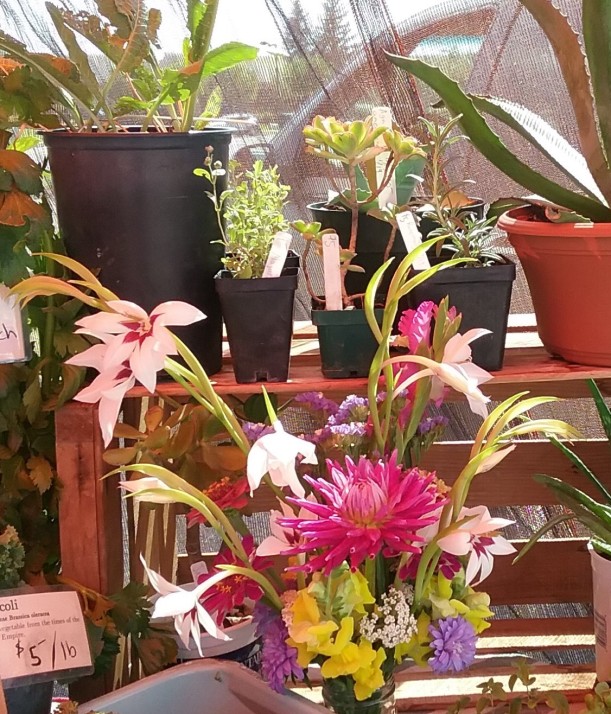
Find Vally’s flower arrangements at the Tuesday Farmers Market, 3-6 p.m. at the mall, outside J.C. Penney, under the orange awning, now through Oct. 8, 2019.







